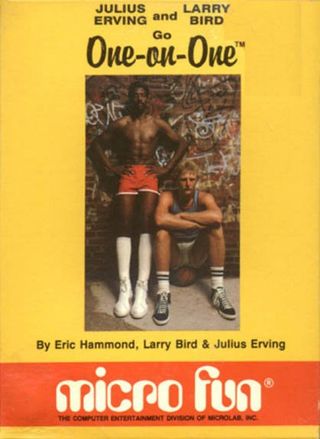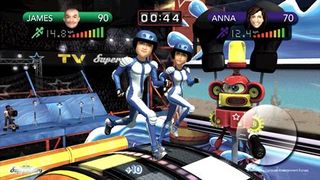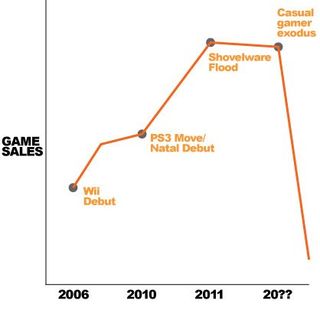Could motion control cause a game market "crash"?
How waggle may one day crumple the industry
The main problem is that, for the most part, motion controls don’t add anything significant to the hardcore gaming experience. But they can certainly take things away; hardcore gamers need to have their character attack right now, when they press a button, not half a second later when they complete a swing of the controller (which may end up interpreted as some other motion). Motion control makes gaming slow and inconsistent, two things that will always send dedicated gamers returning to their “dated” game pads.

Above: "How I press button?"
We’re again hearing the same claims we heard about the Wii, telling us that PS Move and Project Natal will appeal to casual gamers (who are apparentlyintimidatednot only by one button, but by any controller at all), but will also be superior to the “kiddy” Wii by being way more accurate and thus somehowawesome for hardcore gaming. Yet theinitial batch of gamesis anything but hardcore, aside from perhaps the increasingly niche SOCOM. Really, all we’re seeing from Natal and PS Move so far are better-looking Wii games, which may or may not noticeably improve on the controls.

Above: Originally I had a really labored, bizarre metaphor about how casual gamers are this crow, and they'd fly away and break the golden eggs by dropping Move/Natal on them. Instead, enjoy this context-less image
Regardless of the potential for actual, successful hardcore games designed around Move and Natal, the Wii has shown that where there be motion, there be hordes of lazy developers ready to barf up half-digested casual-game carcasses that aren’t so much “casual” as “broken.” It’s not Nintendo’s fault the Wii is so full of shit that its disc slot glows brown. Nintendo is still making fantastic games that take advantage of motion control (Super Mario Galaxy makes it worth owning a Wii all by its beautiful, sphere-trekking lonesome). But when you’re the cool kid on the block, all the phonies copy you in droves, but never really understand what makes you cool.
What do we see in store for Move? Wii Sports Boxing: Buff Sweaty Dudes Edition. What’s in store for Natal? A soccer game with reeeeeallly noticeable lag. And this is the stuff they’re proud to show off. Wait till Z-list developers start shoving their way through the door with their taped-together party-game code. Either the shelves in game stores will have to get bigger, or, well, I don’t want to think about it. Luckily, the 360 and PS3 at least have a head-start, in that once more casual gamers are lured to the systems by the tantalizing, no-brains-required motion control, they’ll have a lot of real gaming options. But over time, more “Insert-cute-thing-followed-by-the-letter-Z” games will start crowding in.

Above: Coming to a PS3 and 360 near you
Sign up to the GamesRadar+ Newsletter
Weekly digests, tales from the communities you love, and more
Of course, for at least a little while, the tide of garbage will be held back by Sony and Microsoft’s own third-party approval processes, which are currently far stricter than Nintendo’s. But what happens if the lure of clueless fly-by-night publishers with fistfuls of license fees becomes too strong? What if the stalwarts of hardcore gaming decide there’s more money to be made by opening their systems to a flood ofmediocre-and-below casual junk? Then we’ll be back in 1983 all over again: tons of copycat garbage competing for the attention of inexperienced game-purchasers. Now, I can’t be certain we’ll see the exact same behavior that we saw in 1983, because after all, it was a different time back then.

Above: Short shorts, long socks
However, because evidence has already pointed to a trend of people purchasing and then not really playing their Wiis as early as a few years ago, when the Wii was young and had fewer junk titles, what does that mean for all those man-hours, all that money invested in games and hardware? With the debut of Move and Natal, the best-case scenario, of course, is Microsoft and Sony’s stated goal: draw in casual gamers, turn them into semi-hardcore gamers, and rake in the dough as the 360 and PS3 increase in sales. Well, my bet is that over the long term, that scenario is unlikely, since we’ve already seen that casual gamers won’t buy a lot of games. Even if Natal and Move do bring in a surge of console and game sales initially, I’m betting that bubble will only inflate for so long.
The second-best-case (or second-worst-case) scenario is that the bubble pops, but it happens before Sony and Microsoft can invest too much in motion control. So then we’d be looking at Natal and Move becoming mostly harmless failures: the casual gamers play with them for a while, then go back to doing whatever the hell non-gamers do with their hours and hours of free time, and Natal and Move just become one more goofy peripheral blip in videogame history.
However, I’m here to talk about the worst-case scenario, the one that I believe is a very real possibility: Casual gamers flock to PS3 and 360. Sony and Microsoft initially get what they expect: non-gamers becoming casual gamers. A huge demand for more casual games causes shovelware developers to follow. Jobs either need to be created to fill the demand for more games, or developers within bigger companies need to be shifted to casual projects. So now the market overall has expanded, and everyone is happily swimming in money. Hardcore gamers are still buying hardcore games, but now a whole new audience is buying (maybe) a few hardcore games, as well as all the assembly-line clones now flooding PS3 and 360.

Above: Hardcore motion control gaming
As in 1983, the bullshit flows so thick that casual, and by this point even some hardcore gamers, get confused and can’t tell what’s good and what isn’t. Too many people are disappointed by one too many waggly, buggy games, and they just stop playing altogether. Hell, even if the junk games don’t drive the casual gamers away, the novelty of videogames will wear off anyway for all the Wii Fit moms. If this engine gets rolling long enough that a big portion of the industry is devoted to feeding the fickle, uninformed tastes of people who never were gamers in the first place and can’t really be converted, well, that’s when part of that train goes right off a cliff.
If “regular folk” stop buying, but hardcore gamers still mostly go about business as usual (and that second part is a near-certainty), we can’t see a true game market crash. But it could be a crumple. Remember, in order to fill the demand for all those casual games, developers and publishers would have to create more jobs. But once that demand goes away, those jobs won’t be needed anymore.

Above: Graph not necessarily scientifically accurate
I’m picturing all those shovelware studios going under one after another, while established game companies face considerable layoffs as the industry re-thinks the whole motion-control craze and its potential (lack of) longevity. The problem for the big game companies would be twofold: not only would they have wasted money on producing games that aren’t sustainable, but they would probably have wasted some of their bright talent on those games, meaning that even the quality of hardcore games could suffer as a result.
Motion control can’t kill the games industry. But it could give it a hefty kick in the nuts.
Apr 6, 2010


7 dumbass things everyone will do when they play Natal
If you are a dick, you will not be able to resist doing these

Has the Wii really improved anything?
With all of Nintendo's big first-party franchises now out on the Wii, we look at whether motion control has really revolutionised any of them

Every PlayStation Move game and how much you care about them
Can we just call it "SOCOM 4, EyePet and a bunch of Wii games"?












